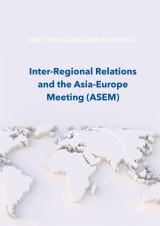Details

Inter-Regional Relations and the Asia-Europe Meeting (ASEM)
|
117,69 € |
|
| Verlag: | Palgrave Macmillan |
| Format: | |
| Veröffentl.: | 09.08.2017 |
| ISBN/EAN: | 9781137597649 |
| Sprache: | englisch |
Dieses eBook enthält ein Wasserzeichen.
Beschreibungen
This edited volume examines contemporary relations between Europe and Asia through the prism of the Asia-Europe Meeting (ASEM). ASEM is an informal forum for dialogue and cooperation between 53 partners from both regions. Having started in 1996, ASEM aims to enhance political dialogue, strengthen economic cooperation, and promote socio-cultural exchange. The book provides insights into past achievements, current challenges, and possible new directions for ASEM as a dialogue forum. The chapters focus on institutional design, the security agenda, economic cooperation, and cultural exchange and civil society outreach through the Asia-Europe Foundation. They also zoom in on ASEM’s Parliamentary Partnership, and the ongoing challenge of public awareness and visibility. Furthermore, they critically examine the implications of the widening process, the attempts to reinvigorate the forum, and the varied perspectives on ASEM’s value for both regions. Appealing to policy-makers, researchers, and students, this volume provides an in-depth analysis of a wide range of issues relating to the role of ASEM in contemporary international relations. <p> <br/></p>
<p>Introduction (Bart Gaens and Gauri Khandekar)<b></b></p> <p>Chapter I: The Asia-Europe Meeting (ASEM): Background, Purpose, and Functions (Bart Gaens)</p> <p>Chapter II: ASEM and the Security Agenda – Talking the Talk but Also Walking the Walk? (Axel Berkofsky)</p> <p> </p> <p>Chapter III: ASEM: Partnership for Greater Growth? (Gauri Khandekar)</p> <p> </p> <p>Chapter IV: A Value-Added ASEM: The Socio-Cultural Dialogue (Huong Le Thu)</p> <p> </p> <p>Chapter V: ASEM and the People’s Involvement: A Focus on the Parliamentary Partnership (ASEP) (Silja Keva)</p> <p> </p> <p>Chapter VI: ASEM and the Promotion of Connectivity between Asian and European Publics (Lai Suet-Yi)</p> <p> </p> <p>Chapter VII: ASEM’s Process of Enlargement and its Implications (Bart Gaens)</p> <p> </p> <p>Chapter VIII: Reinventing ASEM: A Need for Relevance (Gauri Khandekar)</p> <p> </p> <p>Chapter IX: The Value and Limitations of Comprehensive Multilateralism: An EU Perspective on the Asia-Europe Meeting (Thomas Christiansen and Shelly Tsui)</p> <p></p> <p>Chapter X: ASEM: An Asian perspective (Roopmati Khandekar)</p> <p> </p> <p>Conclusions: ASEM towards the next decade (Bart Gaens and Gauri Khandekar)</p> <p><b> </b></p>
<p> </p> <p>Bart Gaens is Senior Research Fellow at the Finnish Institute of International Affairs (FIIA). He is also Specially-Appointed Associate Professor at the University of Osaka, Japan, and Adjunct Professor at the University of Helsinki. He has published on Europe-Asia relations with special focus on the ASEM process.</p> <p></p> <p>Gauri Khandekar is Deputy Director and Director Europe at think tank Global Relations Forum based in its office in Brussels, Belgium. Gauri is the author of five books on Asia-Europe relations. </p>
This edited volume examines contemporary relations between Europe and Asia through the prism of the Asia-Europe Meeting (ASEM). ASEM is an informal forum for dialogue and cooperation between 53 partners from both regions. Having started in 1996, ASEM aims to enhance political dialogue, strengthen economic cooperation, and promote socio-cultural exchange. The book provides insights into past achievements, current challenges, and possible new directions for ASEM as a dialogue forum. The chapters focus on institutional design, the security agenda, economic cooperation, and cultural exchange and civil society outreach through the Asia-Europe Foundation. They also zoom in on ASEM’s Parliamentary Partnership, and the ongoing challenge of public awareness and visibility. Furthermore, they critically examine the implications of the widening process, the attempts to reinvigorate the forum, and the varied perspectives on ASEM’s value for both regions. Appealing to policy-makers, researchers, and students, this volume provides an in-depth analysis of a wide range of issues relating to the role of ASEM in contemporary international relations. <p> <br/></p>
<p>Offers an up-to-date overview of the Asia-Europe Meeting process</p><p>Analyses progress made in political/security-related dialogue, economic cooperation, and socio-cultural exchange, as well as in involving the different stakeholder groups</p><p>Provides insights into past achievements of over two decades, current challenges, and possible new directions for ASEM as a dialogue forum entering its third decade</p><p>Includes supplementary material: sn.pub/extras</p>
<p></p><ul><li>Offers an up-to-date overview of the Asia-Europe Meeting process</li><li>Analyses progress made in political/security-related dialogue, economic cooperation, and socio-cultural exchange, as well as in involving the different stakeholder groups</li><li>Provides insights into past achievements of over two decades, current challenges, and possible new directions for ASEM as a dialogue forum entering its third decade</li></ul><p></p><p></p>
Diese Produkte könnten Sie auch interessieren:

Inclusión educativa de niños, niñas y adolescentes migrantes venezolanos, en Colombia

von: Douglas Jiménez

15,99 €
















